There is a view that toenail fungus is purely a matter of aesthetics and will not harm human health. This posture is extremely incorrect because the toxins produced by the pathogenic fungi can enter the bloodstream and cause poisoning of the body with very serious consequences. In addition, sick people are the source of infection and can infect large numbers of other people.
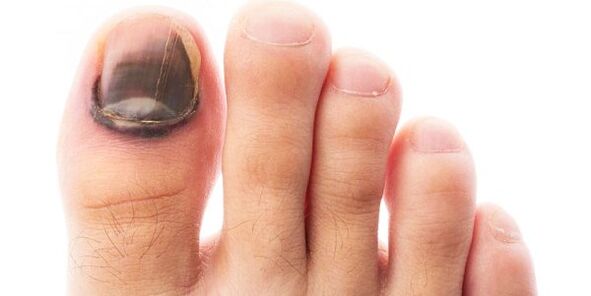
Reason for appearing
Onychomycosis - a fungal infection of the nail plates on the legs or arms - is most common in people who lead an active lifestyle: going to the pool, gym, spa, vacationing at a seaside resort.
Infecting the skin and nails of people with strong immune systems, the spores of the fungus remain dormant for a period of time. Their transition to development and reproduction may occur under the influence of:
- Weakened the body's defenses due to viral diseases,
- Endocrine diseases such as diabetes and hypothyroidism,
- Stressful conditions, excessive stress and agitation,
- Varicose veins in the lower extremities, disrupting normal blood circulation,
- Bruises, abrasions, cracks and other injuries to feet and nails,
- Wearing closed shoes for long periods of time, leading to increased sweating,
- wearing synthetic tights or socks,
- metabolic disorders, obesity,
- Failure to observe personal hygiene rules.

The risk group includes people with chronic disease of the internal organs - kidneys, liver, bile ducts, and patients on long-term antibiotics, hormonal drugs, including birth control pills.
Types of Onychomycosis
There are more than 500 opportunistic fungi that can infest human skin and nails.
The most common causes of onychomycosis are:
- Dermatophytes. These include fungi such as Trichophyton, Microsporum and Epidermophyton. The disease starts on the nail plate and if left untreated, it can spread throughout the foot.
- Yeast Candida. In most cases, the infection occurs in a place with high humidity - a sauna, bathtub or swimming pool.
- Mold, the main sign of its failure is a change in nail color - from dirty green to brown and black.
First, the fungus affects the thumb nail, and then other areas, especially the little finger. All types of onychomycosis are accompanied by severe itching in the interdigital area, burning and an unpleasant putrid smell caused by the decomposition of fungal waste.
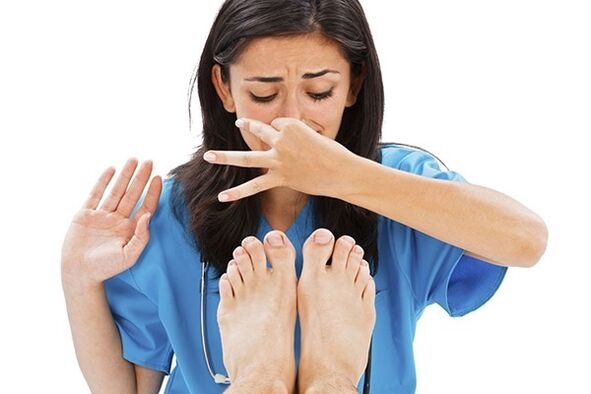
stage of disease
Any kind of fungus requires medication. Before making an appointment, the doctor must understand what stage of the disease is and determine the extent of damage to the nail plate.
According to clinical manifestations, onychomycosis is divided into the following stages:
- Normal nutrition - the initial stage of the disease, in which the nails gradually change color, spots and streaks appear on them. The nail plate still maintains its normal shape, thickness and healthy shine.
- hypertrophy. Nails thicken and become dull and brittle, chipping along the edges. Patients experience pain when walking in tight shoes.
- shrink. True to the stage name, the nails are quickly broken, bent and separated from the nail bed. The plate becomes very thin and brown spots appear underneath - the focal point of pathogen invasion. Eventually, the nails are completely torn off.
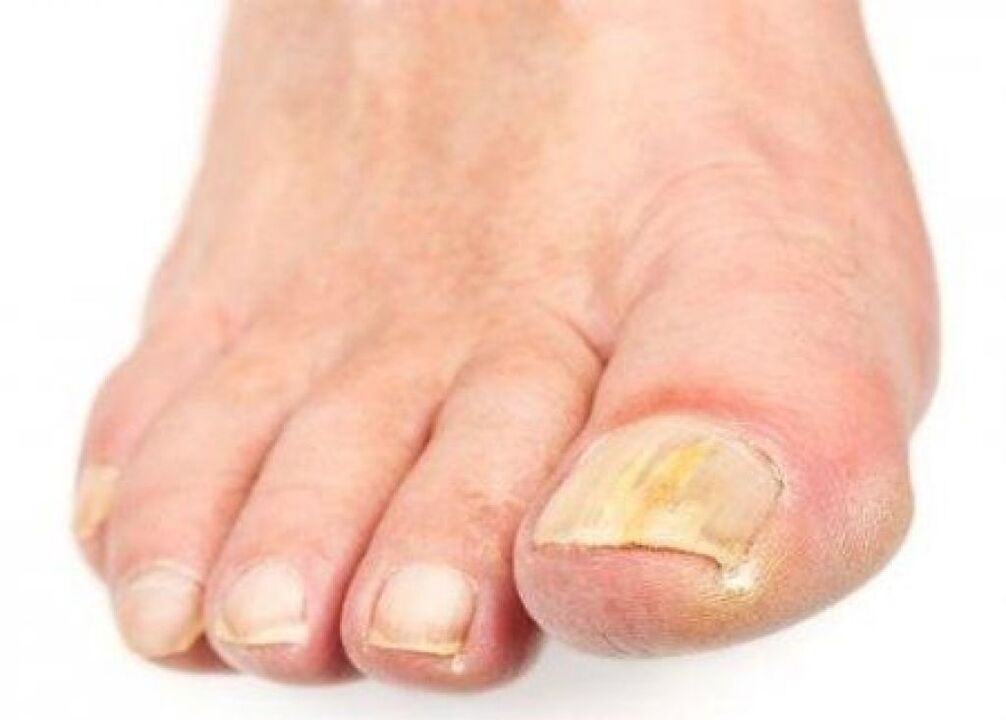
The more severe the disease, the longer and harder it will take to get rid of it. If onychomycosis can be cured with the help of traditional medicine in the initial nutritionally normal stage, then in the final stage it is often even necessary to remove the affected nail by surgical means.
symptom
In order to start treatment in a timely manner, it is necessary to understand the manifestations of onychomycosis of the nails at each stage.

Initially, the main symptom of nail fungus is reddening of the skin in the interdigital area, with mild peeling and itching. Subsequently, the symptoms of a fungal infection develop in the following order:
- The nailfold becomes red, swollen, and painful,
- Depending on the type of pathogen, the nails start to turn from dirty yellow to black,
- Spots, grooves, nodules and streaks appear on the surface of the sheet,
- Nail thickening and exfoliation,
- A mass of white matter gathered in the space under the armour, exuding an unpleasant smell,
- The keratinized nail plate begins to crumble along the edges,
- The nails completely fell off the bed and were rejected.
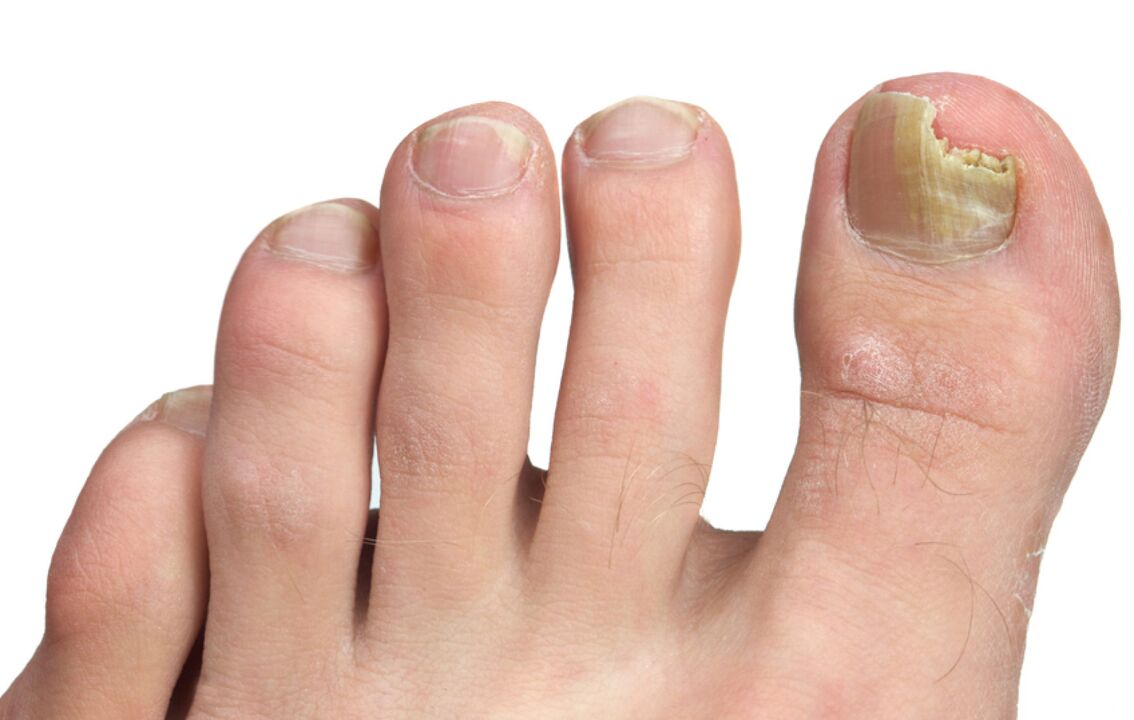
Feet infected with nail fungus look very unpleasant to others, so the patient has to hide them, which is especially difficult during the warmer seasons. Also, running onychomycosis can lead to complications.
what is a dangerous disease
Many patients are reluctant to seek medical attention at an early stage or fail to recognize the first symptoms of onychomycosis, causing it to transform into a chronic form that can be lifelong. At the same time, in the case of normal immunity, the fungus will "freeze" to a certain extent, and any of the triggering factors mentioned above can again transfer the disease to the active phase.
The following categories belong to the risk group for complications of fungal nail infections:
- children under the age of 12,
- pregnant,
- breastfeeding women,
- Older people.
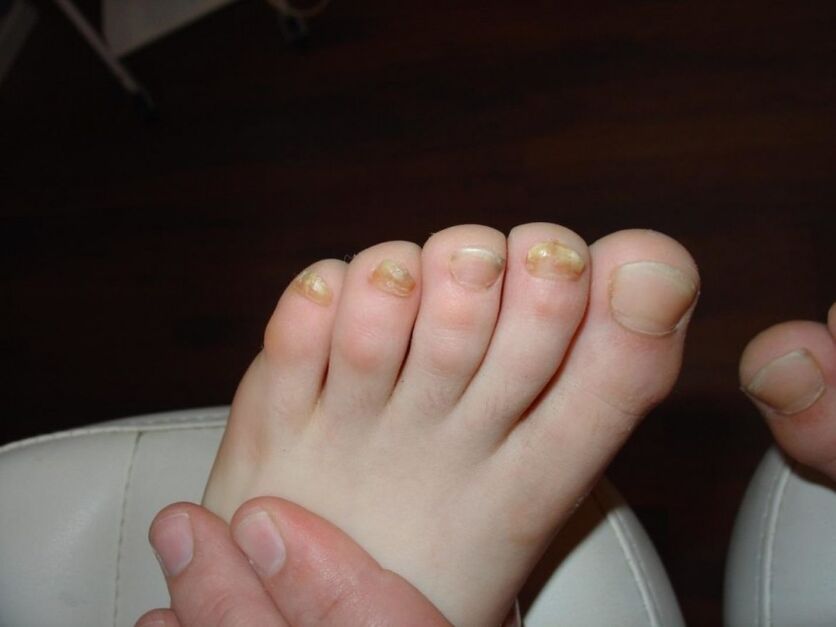
Against the background of reduced physical defenses in these individuals, the disease can spread rapidly, leading to a further weakening of immunity and possible consequences of:
- Allergic reaction to bronchial asthma,
- aggravating the course of visceral chronic diseases,
- Poisoning of the body due to the infiltration of toxins into the blood,
- dysbacteriosis,
- New inflammatory lesions appear on the skin,
- Nervous system diseases, psychological problems.
Since nail mycosis refers to an infectious disease, not only the patient himself, but all of his personal belongings are a persistent source of infection for others. If onychomycosis is detected in a woman during pregnancy, there is a threat that the unborn baby will be born with allergic tendencies.
diagnosis
Mycoses of the skin and nails are treated by a dermatologist or mycologist. For a consultation, you can contact the clinic where these specialists see or a dermatology pharmacy.
After interviewing the patient, the doctor will be able to picture the appearance and progression of the disease. The following measures will help make an accurate diagnosis and prescribe the most effective treatment:
- Visually inspect the affected nail with a Wood UV lamp,
- Take skin and nails for examination,
- General blood and urine tests.
The biological material obtained by scraping is sent to a laboratory to be studied under a microscope, allowing the fungal nature of the disease to be determined.
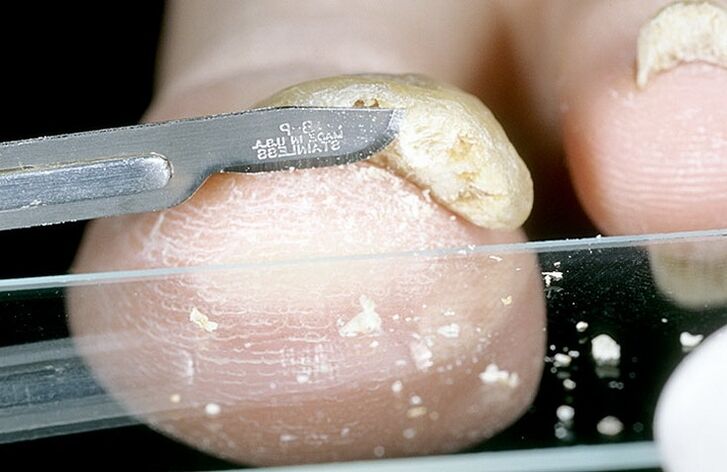
To elucidate the types and strains of pathogenic microorganisms, fungal cultures were placed in nutrient media to create optimal conditions for their development. After 10-14 days, by the type and shape of the colonies, not only can the pathogen be identified, but its response to the most common drugs can also be determined.
The fastest and most accurate method is considered PCR (polymerase chain reaction). The biological material is treated with special enzymes that allow the study of fungi at the DNA level. As a result, the type of pathogen was identified and an accurate description was given.
On the basis of the above procedure, a final diagnosis of the patient is made and the best plan to remove the fungus as soon as possible is developed.

treat
Dermatologists promise a positive prognosis for onychomycosis only if patients strictly follow all of their prescriptions and recommendations.
In most cases, complex treatment is performed, including the use of topical ointments, creams, and varnishes, oral antifungals, and alternative treatments.
Keratolytics are used to soften and exfoliate affected nail plates. You can also get rid of the manifestations of fungal infections with the help of special varnishes.
Oral antifungal antibiotics are prescribed if the fungus on the nails has advanced to an advanced stage, or if there is a threat of secondary infection, which may be caused by pathogenic bacteria entering the affected area.
You can use a traditional healer at home to speed up the healing process. The most effective, according to patients, are the following procedures:
- bathe with baking soda or herbal soup,
- apple cider vinegar lotion,
- Compressed with celandine tincture,
- Salve based on propolis and other bee products.
To destroy pathogenic microorganisms, nails can be treated with essential oils of cinnamon, clove, fir, oregano, or lemon before applying antifungal medications.
Many dermatology centers offer laser beam removal of fungus from nails. This procedure allows you to quickly and painlessly remove the affected nail plate and is performed on an outpatient basis.
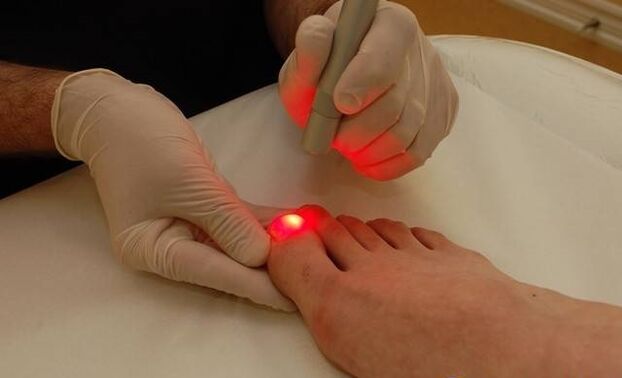
how can you get a fungus
Onychomycosis is a contagious fungal disease that is easily spread from person to person through household contact.
Most of the time it happens like this:
- When walking barefoot in public places with high humidity - saunas, spas, gyms, swimming pools, beaches,
- When trying on or wearing someone else's shoes or socks,
- Through bedding, towels, towels, brushes and other personal items.
When visiting a nail salon, it is necessary to pay attention to the disinfection of tools, because in many cases fungal infections occur due to the fault of unscrupulous employees of beauty salons.
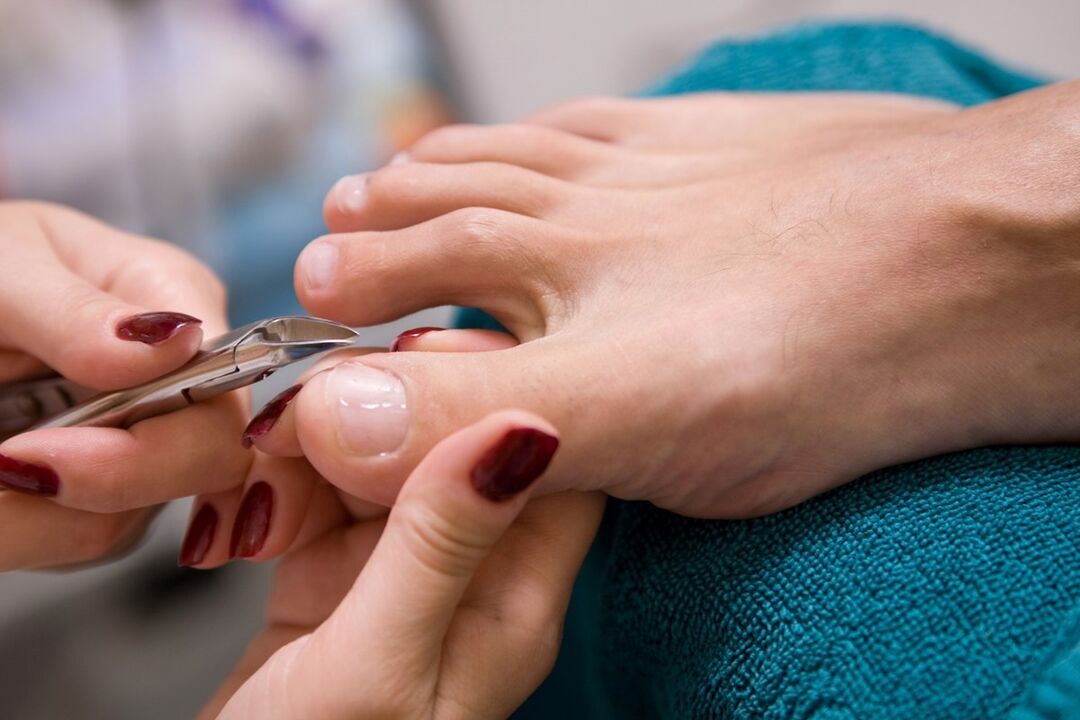
prevention
To prevent pathogenic fungi from multiplying even on your nails or skin, you need to take care of your health and strengthen your immune system by following these recommendations:
- Reject bad habits.
- stay healthy.
- Spend more time outdoors.
- Balance your diet by including foods that contain nutrients and vitamins.
- Pay attention to personal hygiene.
- Timely cure all chronic diseases.
- Wear quality shoes and socks that won't confine or hover your feet.
- Shoes used in the pool, gym or beach should be regularly treated with disinfectant.
After you notice inexplicable changes in your skin or nails, you should make an appointment with a dermatologist to start treatment early and get rid of the fungus as quickly as possible.
























